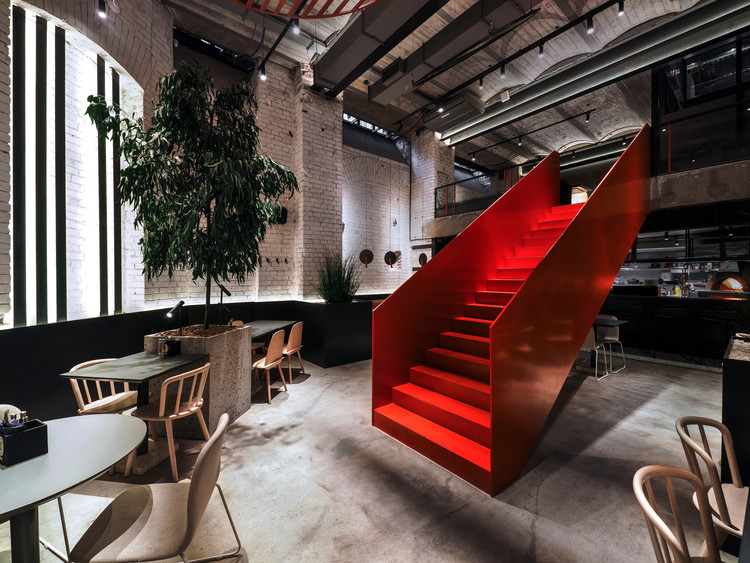Punggol Waterway Terraces group8asia + Aedas
2016-05-18 19:00
© Patrick Bingham-Hall
帕特里克·宾厄姆-霍尔


架构师提供的文本描述。展望未来,回顾过去,庞戈勒水路平台构成了21世纪可持续大众住房的蓝图,标志着新加坡回归了最初的社区自豪感和认同感。
Text description provided by the architects. Looking to the future whilst looking back to the past, the Punggol Waterway Terraces form a blueprint for 21st century sustainable mass housing and mark a return to Singapore’s original ethos of community pride and identity.
© Patrick Bingham-Hall
帕特里克·宾厄姆-霍尔


原来的SIT公共住宅大厦是现代清洁城市主义的热带适应。由于它们是在空调出现之前就设计好的,所以这些公寓需要交叉安装,它们被悬挂在阴影下,并被定位以避免下午的阳光照射。20世纪70年代初,当第一批大规模的hdb大厦建在皇后镇时,那种“热带必要性现代主义设计”建筑混合建筑象征着一个新独立的新加坡。
The original SIT public housing blocks were tropical adaptations of contemporary clean-lined odernism. As they were designed well before the advent of airconditioning,the apartments required cross- entilation, they were shaded by overhangs, and were orientated to avoid the heat of the afternoon sun. When the first large-scale HDB blocks were built in Queenstown in the early 1970s, that ‘tropical-necessity modernist-design’ architectural hybrid symbolised a newly independent Singapore.




随着新加坡变得越来越富裕,随着全球建筑时尚的改变,那些英勇的热带现代主义形式将悄然消失。他们被一种建筑所取代,这种建筑渴望维护新加坡的世俗化,但设计变得越来越普遍,许多发展都含蓄地反社会,而且这些结构是不可持续的,非热带的。
As Singapore grew more affluent and as global architectural fashions changed, those heroic tropical-modernist forms were to quietly disappear. They were replaced by an architecture that itched to assert Singapore’s worldliness, but the designs became increasingly generic, many of the developments were implicitly anti-social,and the structures were unsustainably non-tropical.
© Patrick Bingham-Hall
帕特里克·宾厄姆-霍尔


然而,面对全球变暖和丧失社区认同,香港回归热带现代主义设计的原则和精神,特别是在公共房屋方面。
However, in the face of global warming and the loss of community identity, the pendulum has swung back to the principles and the spirit of tropical-modernist design, especially in the field of public housing.
© Patrick Bingham-Hall
帕特里克·宾厄姆-霍尔


水道梯田的巨大质量和基本设计要素并没有被隐藏起来,相反,它们被展示给公众和居民,作为对21世纪对可持续的、令人愉快的、高密度城市生活方式的明确回应。
The sheer mass and the fundamental design elements of the Waterway Terraces are not hidden, they instead are presented to the public and the residents as an unequivocal response to the 21st century requirements for a sustainable, yet enjoyable, high-density urban lifestyle.
一系列的规划策略提供了被动的气候控制-交叉通风和遮阳-同时最大限度地将公寓朝向将场地平分的水道。
A matrix of planning strategies provides passive climatic control – cross ventilation and shading from the sun – whilst maximising the orientation of the apartments towards the waterway that bisects the site.
© Patrick Bingham-Hall
帕特里克·宾厄姆-霍尔


这些街区的“武器”作为梯田,以六角形图为基础,因此所有居民都与景观和邻里有着直接的经验联系。这些公寓通过“朱丽叶”阳台上起伏的缎带来遮挡炎热和雨水,这些阳台充当了装饰性的遮阳装置。
Set upon linked hexagonal plans, the ‘arms’ of the blocks step down to the waterway as terraces, so all the residents have a direct experiential connection with the landscape and with their neighbourhood. The apartments are shielded from the heat and the rain by undulating ribbons of ‘Juliet’ balconies, which perform as decorative sun-shading devices.




一条连续的无死角走廊贯穿着这两个部门每一层的长度,而通过巧妙的规划手段,双层走廊实际上可以促进交叉通风和垂直冷却,而不是阻碍流向公寓的气流。由于六角形的街区计划,三条走廊在离电梯核心120度的地方,为三人一组的公寓提供服务。每套公寓都直接通过电梯芯风道和分组之间插入的空隙进行通风。
A continuous no-dead-end corridor runs the length of every floor in each of the two sectors, and by virtue of an ingenious planning manoeuvre, the double-loaded corridors actually facilitate cross-ventilation and vertical cooling, instead of blocking the airflow to the apartments. Due to the hexagonal block plans, three corridors are angled at 120 degrees from the lift cores to serve apartments grouped in threes. Each apartment is directly ventilated by the lift-core breezeways and by voids inserted between the groupings.
© Patrick Bingham-Hall
帕特里克·宾厄姆-霍尔


被动热带设计的基本原则已经被创造性地重新校准,然后在一个巨大的尺度上被表达出来,而环境协调的规划和集合又在人类的尺度上重新引入了一种共同的认同感。
The fundamental principles of passive tropical design have been inventively recalibrated and then expressed at a monumental scale, whilst the contextually-attuned planning and massing have reintroduced a sense of communal identity at a human scale.
© Patrick Bingham-Hall
帕特里克·宾厄姆-霍尔


水道梯田是零能源大规模住宅的真正先导,这对于亚洲城市的持续增长至关重要。
Waterway Terraces is a genuine precursor to the zero-energy mass housing that will be essential for the continued growth of Asia’s cities.




























Architects group8asia, Aedas
Location Punggol, Singapore
Category Housing
Concept Team Manuel Der Hagopian, Grégoire Du Pasquier, Adrien Besson, Anne Luyet, Nicolas Moser, Laurence Savy, Nguyen Kien, Guillaume Desormeaux, Vu Hoang Ha
Project Team Carlo Montoya, Armand Devillard, Duong Bao Trung, Nguyen Duy Tan, Le Hai Anh, Nguyen Viet Hung, Dam Van Tam, Vu Thu Nga, Vu Ngoc Tu, Vu Dong Thanh, Ngo Trong Anh, Phan Thi Bich Lien, Nguyen Phuong Chi, Bui Le Minh, Nguyen Trung Thanh, Florence Thonney, Do Dang Tuat, Nguyen Duc Cuong, Le Quang, Thomas Sponti
Area 258000.0 sqm
Project Year 2015
Photographs Patrick Bingham-Hall































